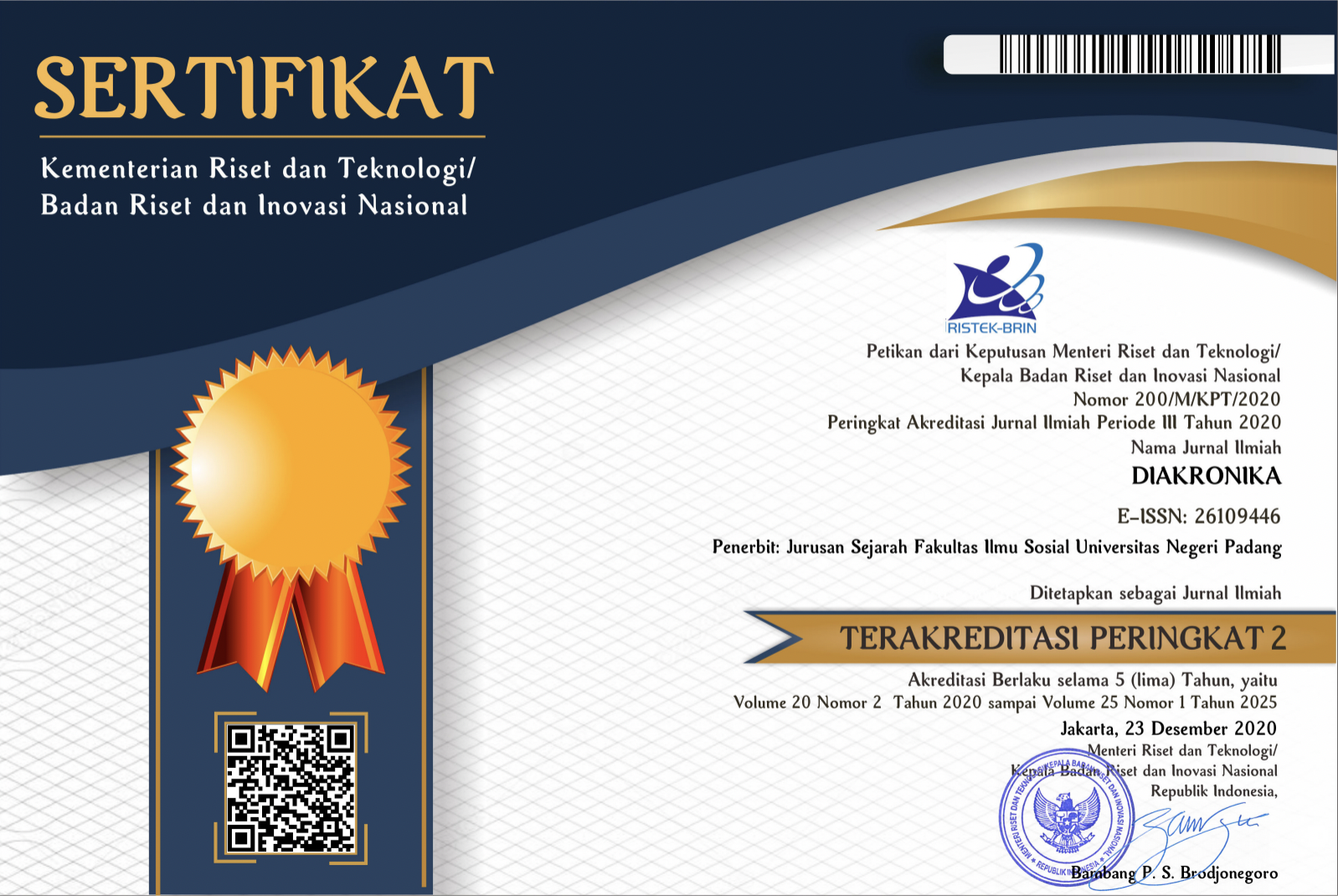Persebaran Penyakit di Kawasan Laut Jawa Abad XIX - XX
Abstract
This article discussed about the process of diseases spreading along the Java Sea area during the 19th and the early 20th century. This study utilized historical method with an aim to reconstruct past events, especially on the outbreaks happened in the Java Sea area and how the colonial governmnet dealt with the occurrence. The article applied Braudel’s structural theory (1988) to analyze the existence of structures, which were taking a role in the process of diseases spreading. This analysis was supported by the concept of ‘silent barter’, developed by Knapen (1995) as a benchmark to determine factors that caused the spread. The results allowed us to discover that the dynamics of shipping and trading in the Java Sea at that time were part of the whole pandemic situation. There were at least two diseases discussed as the main focus of this article, smallpox and cholera, as these two severely affected the trading and shipping activity. These diseases were carried by the crews of ships escaping the quarantine doctors who carried out medical examination at various ports. Several ports in Java, such as Batavia, Semarang, Cirebon, and Surabaya, had become the epicenters of the outbreak. The government applied a regulation to attached a yellow flag to the ship contaminated by the plague before they entered the port area. The yellow flag functioned as an identifying marker. The regulation was supposed to limit the spread of diseases from the coastal area of Java to the mainland, as well as to gain more attention from other ships and doctors resided near the ports. The yellow flag system made it easier for the government and doctors to handle smallpox and cholera outbreaks, even though there had been some aberrations in economic activities in this area.
Downloads
References
Bataviaasch Handelsblad,. (1911, Desember). Bataviaasch Handelsblad. 2.
Bataviaasch Nieuwsblad. (1927, January 22). Bataviaasch Nieuwsblad. 2.
Beaglehole, R. et. al. (1993). Basic Epidemiology. WHO.
Boeke, J. H. (1983). Prakapitalisme Di Asia. Sinar Harapan.
Boomgaard, P., and A. J. Goosjen. (1991). Changing Economy in Indonesia (Vol. 11). Royal Topical Institut (KIT).
Boomgaard, P., et. al. (1997). Paper Landschapes: Exploration in the Environmental History of Indonesia. KITLV Press.
Boomgard, P., Sciortino, R., & Smyth, I. (1996). Health Care in Java: Past and Present. KITLV Press.
Bosma, U. (2015). Smallpox, Vaccinations, and Demographic Divergences in Nineteenth-Century Colonial Indonesia. Bijdragen Tot de Taal-, Land- En Volkenkunde, 117.
Braudel, F. (1988). Civilization an Capitalism 15th-18th Century: The Struktures of Everyday Life The Limits of Possible (Vol. 1). Collins/Fontana Press.
Breman, J. (1986). Penguasaan tanah dan tenaga kerja, Jawa di masa kolonial. Lembaga Penelitian, Pendidikan dan Penerangan Ekonomi dan Sosial.
De Indische Courant. (1938, November 2). 2 November 1938.
De Java Bode. (n.d.). De Java Bode. 2.
De Java Bode. (1918). De Java Bode.
De Preanger Bode. (1917, Mei). 7 Mei 1917.
De Sumatra Post,. (1911, Oktober). De Sumatra Post. 2.
Furnivall, J. S. (1967). Nederlands Indie: A Study of Plural Economy. Chambridge University Press.
Gelderen, J. van. (1974). Tanah Dan Penduduk Di Indonesia. Bhratara.
Het nieuws van den dag voor Nederlandsch Indie. (1915, Oktober). Het nieuws van den dag voor Nederlandsch Indie. 2.
Jaelani, G. A. (2013). Penyakit kelamin di Jawa, 1812-1942. Syabas Books.
Kartodirdjo, S. (1987). Pengantar Sejarah Indonesia Baru: 1500-1900 (Vol. 1). PT. Gramedia.
Koloniaal Verslag. (1849). Koloniaal Verslag.
Lombard, D. (1996). Nusa Jawa: Silang Budaya. Gramedia Pustaka Utama. https://opac.perpusnas.go.id/DetailOpac.aspx?id=602845
Nitisastro, W. (1970). Population Trends in Indonesia. Cornell University Press.
Peper, B. (1975). Pertumbuhan Penduduk Jawa. Bhratara.
Peter, and A. J. Goosjen. (1991). Changing Economy in Indonesia (Vol. 11). Royal Topical Institut (KIT).
Raffles, T. S. (2002). The History of Java. Narasi.
Reid, A. (1992). Asia Tenggara dalam Kurun Niaga 1450-1680 Tanah di Bawah Angin. Yayasan Obor Indonesia.
Soerabajasch Handelsbla. (1934, June 16). Soerabajasch Handelsblad. 2.
Suryo, J. (1989). Sejarah Sosial Pedesaan Karesidenan Semarang 1830-1900. PSAU Studi Sosial Universitas Gadjah Mada.
Susetyorini, P. (2019). Masalah-Masalah Hukum. Fakultas Hukum UNDIP Semarang, 48, 164–177.
Trisulistiyono, S. (2003). The Java Sea Network. Universiteit Leiden.
Van Doornum et al. - 2020—Leeuwenhoek’s Legatees and Beijerinck’s Beneficiar.pdf. (n.d.). Retrieved August 14. 2021: from https://remote-lib.ui.ac.id:2065/stable/pdf/j.ctvwh8bpb.12.pdf?ab_segments=0%2Fbasic_search_gsv2%2Fcontrol&refreqid=fastly-default%3Aed766d92d3c4af20c9c85c396a2d22d7




